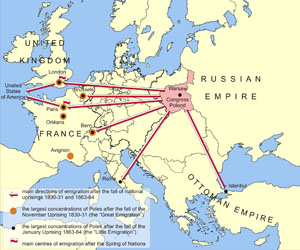2. Directions of Polish emigration in the nineteenth century
 Click image to enlarge
Click image to enlarge
Questions
Description and Analysis
The answers for the “Open Questions”:
- After the November Uprising, the Poles made their way primarily to Turkey (residing mainly in Istanbul), the Italian states and Rome, to Bern in Switzerland, to Orleans, Avignon and Paris in France, to London, England, to Brussels in Belgium and the United States. After the January Uprising, these directions did not change, with exception of Avignon, where the Poles were not settling in. After the Spring of Nations, the biggest Polish communities were formed in London and Paris.
- These countries allow immigrants from the former Poland to freely settle and they generally do not prohibit political activity. Public opinion of these countries was positive about the refugees from the Polish territories.
- Currently, from the centres visible on the map, the largest Polish communities are located in England, Belgium and the United States
Geographical/Historical Context
The Poles, deprived of an independent country in the nineteenth century, did not even for a moment stopped fighting for its regaining. Three national uprisings (1830, 1846, and 1863) and conspiracy activity directed against the governments of the occupants carried out throughout the century had to cause repression and for many patriots, meant the need to emigrate and seek asylum in different European countries.
The largest wave of emigration took place after 1830 and the fall of November Uprising. Scale of the exile and its composition (one could finnd there prominent politicians, writers, poets, and musicians) resulted in the phenomenon known as the Great Emigration. When Russian troops occupied the lands of the former Republic of Poland dealing violently with all people involved in insurgent activities, politicians (members of all bodies of insurgent authorities) were forced to leave the country in the first place. Also, the soldiers of the uprising made their way abroad to avoid the threat of a military court, or at best, trial. Some of the families of refugees followed them which increased numbers of emigrants. Repressions and deteriorating situation of the Poles under the Russian domination in coming years persuaded many to choose life in exile instead of submissive existence in conditions of a police state. It is very difficult to assess the size of this wave of emigration. Different researchers give numbers from 10,000 to 50,000 refugees.
The largest part of emigrants came to France, many chose the German states, a large group settled in the British Isles and Belgium. It is difficult to estimate the number of emigrants who headed for the United States, but in this case high cost of travel was the main barrier.
Next waves of refugees emigrated from the former Polish territories after the fall of the Cracow Uprising in 1846 and the January Uprising in 1863/1864. In terms of social composition and migration direction, these groups corresponded more or less to the characteristics of the Great Emigration. But they were much fewer and did not create so closely consolidated political parties abroad. These groups did not include creative personalities like Mickiewicz or Chopin, hence the attention of historians has not been particularly focused on their fate.
The picture of Polish political emigration in the nineteenth century is completed with the image of patriotic activists. Some of them were repressed in the country for their anti-state (from the occupation authorities point of view) activities. Others deliberately organized centres of pro-Polish propaganda in Western Europe to collect funds and train staff in order to take up armed struggle for the future independency. This activists group consisted of politicians of almost all political views (from nationalism to socialism). The people, who did not share the same view on the economy and social order that was to be introduced in the recovered and free country were united by a common goal – the idea of an independent Poland. Individualists who were most committed to the promotion of the Polish issue on international arena are: a statesman and the father of modern Polish nationalism – Roman Dmowski, a famous pianist and diplomat – Ignacy Jan Paderewski, and the future Chief of State Jozef Pilsudski.
Links
http://www.casahistoria.net/emigration.htm – web portal on the history of immigration in Europe from the nineteenth century (English).
http://www.globalissues.org/article/537/immigration#IntroductionWorldwideImmigrantsStatistics – website devoted to contemporary migration, part of the portal which deals social problems.




Presentation
The map shows the main directions of the Polish political emigration in the nineteenth century. Three main waves of emigration from the former Polish lands need to be identified: the insurgents from 1830 and 1863, and participants of the "Spring of Nations" in the years 1948-1849. This does not mean that the phenomenon of emigration of the Poles disappeared as a result of repression under the occupation in the second half of this century – on the contrary. Nevertheless, during this period, emigration no longer had a mass character and it concerned individuals or small groups which due to hostile activities were forced to seek asylum in different countries of the continent. Also these refugees, however, were heading for countries and cities marked on the map.
Polonia – groups of the Poles who live outside Polish borders.